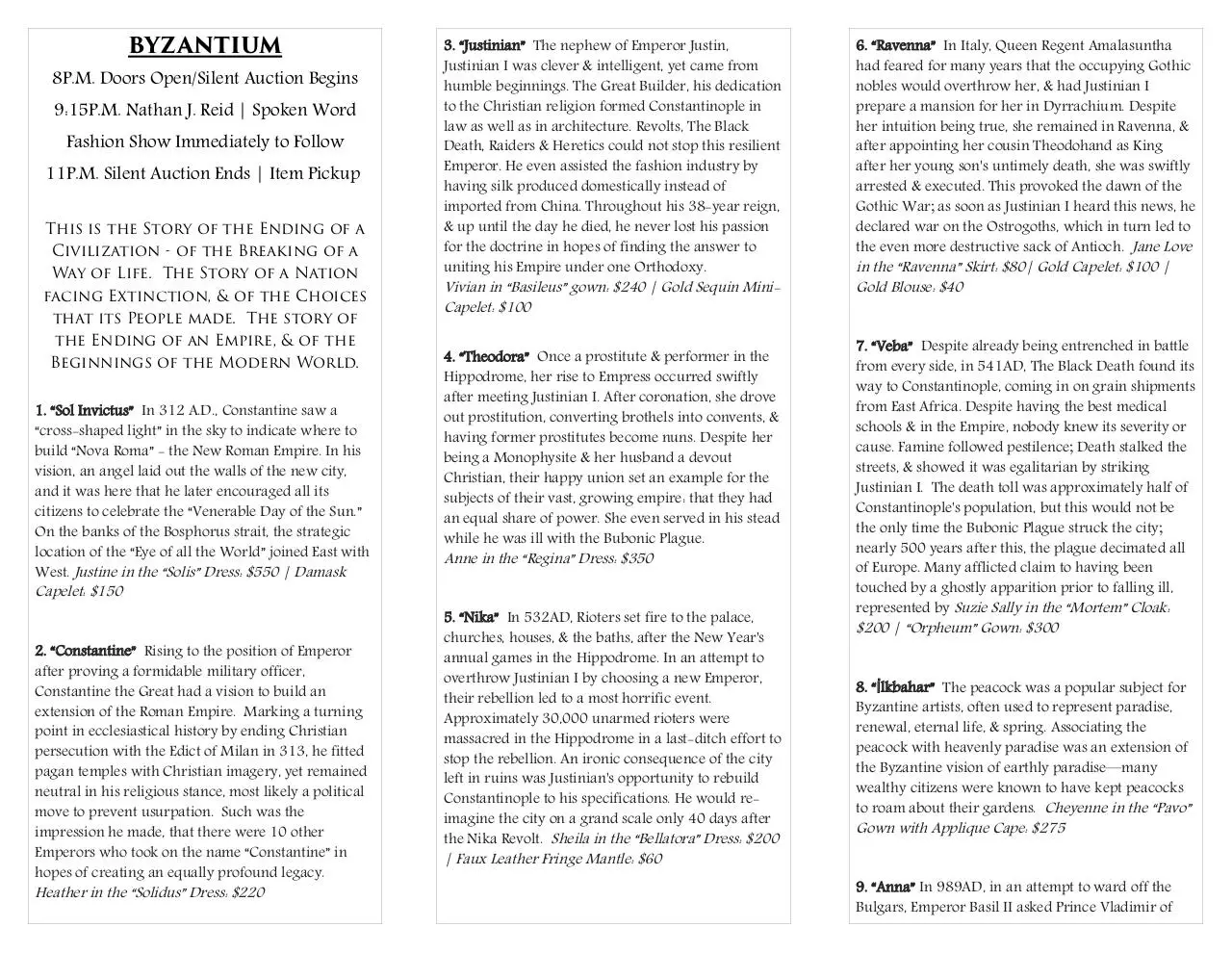ByzantiumBrochure (PDF)
File information
Title: Trifold brochure Template
Author: Andrew Ziem
This PDF 1.4 document has been generated by Writer / OpenOffice.org 3.3, and has been sent on pdf-archive.com on 28/03/2015 at 20:23, from IP address 72.128.x.x.
The current document download page has been viewed 720 times.
File size: 291.48 KB (2 pages).
Privacy: public file


File preview
Kiev to join his army. Vladimir complied, in
exchange for the Emperor's sister Anna's hand in
marriage. Basil II agreed, but only if the Prince would
convert to Orthodoxy. Prince Vladimir assented to his
request, changing the face of the Eastern Empire by
becoming the spiritual successor of the Byzantine
Empire. Lunariea in the “Sponsae” Dress: $325 |
Gold Embossed Mantle: $35
10. “Leo III” Starting off his reign by abdicating the
previous Emperor, Leo III showed his military
prowess by defeating opponents from Arabia with a
little help from “Greek Fire” - a Napalm-like
substance that no other military knew how to make.
On January 7, 730AD, Leo III ordered the destruction
icons. Met with much consternation in the West, the
Empire's Western Synod decreed any attempt to
remove icons would result in excommunication. Leo
III ensured that any & all revolts caused by
iconoclasm were crushed by military force, Victoria
in the “Filioque” Pencil Dress: $300
11. “Schism” Iconoclasm remained a subject of much
controversy for 120 years, until it was finally
resolved in 843AD. Peace would not last, however,
as the final break between ideologies took place in
1054AD. Following over a thousand years of debates
on the nature of their Savior, the Greek-speaking
Eastern Empire was now known as Eastern
Orthodoxy, & the Latin-speaking West became
Roman Catholicism. Maya in the “Schismatis”
Fishtail Gown: $180
12. “Irene” The argument over iconography
continued through the reign of Constantine V & Leo
IV. Leo IV died early in his reign, leading his wife
Irene to be the only woman in the Empire's history to
rule as Regent in her own right. She reinstated the
use of icons, & after being briefly deposed by her son,
had him blinded & exiled. Refusing to recognize
Irene's power, Leo III crowned Charlemagne the
“Emperor of the Romans.” Charlemagne set his sights
on Irene as his wife, but she was deposed and exiled
before she could reply. Helena in the “Basilissa”
Dress: $220 | High-Collar Capelet: $140
13. “Stavroforía” Like dominoes, the strongholds of
the Empire fell one by one to the Turks after the
Battle of Manzikert in 1071AD. The clash between
the Crescent & the Cross caused by The Crusades
truly was one of the most devastating & brutal series
of battles to ever be fought. The capture of
Constantinople may have seemed like a great defeat,
but how can run reign from an Empire in ruin?
Elizabeth in the “Strategikon” Dress: $250 | Gold
Embossed Harness: $60 | Black & Gold Textured
Leggings: $40
SilversÄrk Presents:
Byzantium
[the fallen empire]
Spring/Summer 2015 Fashion Show
celebrating 10 years of SILVERSÄRK
14. “Seljuk” For months, Turkish spies probed
Constantinople for weaknesses. The eve before the
final war that took down the city, Emperor
Constantine XI addressed Sultan Mehmed II in a
letter, stating “As it is clear you desire war more than
peace, so let it be according to your desire. I will
defend my people to the last drop of blood. The
Supreme God calls us both before his judgment seat.”
On April 6, 1453, the Seljuk Turks seized &
conquered Constantinople, ending a reign that lasted
1123 years and 18 days. Kasie in the “Tourkiká”
Overdress: $350 | Gold Tassel Bolero: $90 | Gold
Skirt: $80
IF INTERESTED IN ANY OF THE DESIGNS
SHOWN THIS EVENING, CONTACT
STEPHANIE DIRECTLY AFTER THE SHOW
OR EMAIL: silversarkx@gmail.com
INQUIRIES ABOUT ANY HEADPIECES OR
ACCESSORIES CAN BE MADE AFTER THE
SHOW OR EMAIL:
Deborah Olson: bustlesandbritch@aol.com
Joan Junghans: musesjewelry@gmail.com
March 27, 2015 8P.M.
Hot Water Wherehouse
With Silent auction Items
Benefiting Autism Solution Pieces
BYZANTIUM
8P.M. Doors Open/Silent Auction Begins
9:15P.M. Nathan J. Reid | Spoken Word
Fashion Show Immediately to Follow
11P.M. Silent Auction Ends | Item Pickup
This is the Story of the Ending of a
Civilization - of the Breaking of a
Way of Life. The Story of a Nation
facing Extinction, & of the Choices
that its People made. The story of
the Ending of an Empire, & of the
Beginnings of the Modern World.
1. “Sol Invictus” In 312 A.D., Constantine saw a
“cross-shaped light” in the sky to indicate where to
build “Nova Roma” - the New Roman Empire. In his
vision, an angel laid out the walls of the new city,
and it was here that he later encouraged all its
citizens to celebrate the “Venerable Day of the Sun.”
On the banks of the Bosphorus strait, the strategic
location of the “Eye of all the World” joined East with
West. Justine in the “Solis” Dress: $550 | Damask
Capelet: $150
2. “Constantine” Rising to the position of Emperor
after proving a formidable military officer,
Constantine the Great had a vision to build an
extension of the Roman Empire. Marking a turning
point in ecclesiastical history by ending Christian
persecution with the Edict of Milan in 313, he fitted
pagan temples with Christian imagery, yet remained
neutral in his religious stance, most likely a political
move to prevent usurpation. Such was the
impression he made, that there were 10 other
Emperors who took on the name “Constantine” in
hopes of creating an equally profound legacy.
Heather in the “Solidus” Dress: $220
3. “Justinian” The nephew of Emperor Justin,
Justinian I was clever & intelligent, yet came from
humble beginnings. The Great Builder, his dedication
to the Christian religion formed Constantinople in
law as well as in architecture. Revolts, The Black
Death, Raiders & Heretics could not stop this resilient
Emperor. He even assisted the fashion industry by
having silk produced domestically instead of
imported from China. Throughout his 38-year reign,
& up until the day he died, he never lost his passion
for the doctrine in hopes of finding the answer to
uniting his Empire under one Orthodoxy.
Vivian in “Basileus” gown: $240 | Gold Sequin MiniCapelet: $100
4. “Theodora” Once a prostitute & performer in the
Hippodrome, her rise to Empress occurred swiftly
after meeting Justinian I. After coronation, she drove
out prostitution, converting brothels into convents, &
having former prostitutes become nuns. Despite her
being a Monophysite & her husband a devout
Christian, their happy union set an example for the
subjects of their vast, growing empire: that they had
an equal share of power. She even served in his stead
while he was ill with the Bubonic Plague.
Anne in the “Regina” Dress: $350
5. “Nika” In 532AD, Rioters set fire to the palace,
churches, houses, & the baths, after the New Year's
annual games in the Hippodrome. In an attempt to
overthrow Justinian I by choosing a new Emperor,
their rebellion led to a most horrific event.
Approximately 30,000 unarmed rioters were
massacred in the Hippodrome in a last-ditch effort to
stop the rebellion. An ironic consequence of the city
left in ruins was Justinian's opportunity to rebuild
Constantinople to his specifications. He would reimagine the city on a grand scale only 40 days after
the Nika Revolt. Sheila in the “Bellatora” Dress: $200
| Faux Leather Fringe Mantle: $60
6. “Ravenna” In Italy, Queen Regent Amalasuntha
had feared for many years that the occupying Gothic
nobles would overthrow her, & had Justinian I
prepare a mansion for her in Dyrrachium. Despite
her intuition being true, she remained in Ravenna, &
after appointing her cousin Theodohand as King
after her young son's untimely death, she was swiftly
arrested & executed. This provoked the dawn of the
Gothic War; as soon as Justinian I heard this news, he
declared war on the Ostrogoths, which in turn led to
the even more destructive sack of Antioch. Jane Love
in the “Ravenna” Skirt: $80| Gold Capelet: $100 |
Gold Blouse: $40
7. “Veba” Despite already being entrenched in battle
from every side, in 541AD, The Black Death found its
way to Constantinople, coming in on grain shipments
from East Africa. Despite having the best medical
schools & in the Empire, nobody knew its severity or
cause. Famine followed pestilence; Death stalked the
streets, & showed it was egalitarian by striking
Justinian I. The death toll was approximately half of
Constantinople's population, but this would not be
the only time the Bubonic Plague struck the city;
nearly 500 years after this, the plague decimated all
of Europe. Many afflicted claim to having been
touched by a ghostly apparition prior to falling ill,
represented by Suzie Sally in the “Mortem” Cloak:
$200 | “Orpheum” Gown: $300
8. “İlkbahar” The peacock was a popular subject for
Byzantine artists, often used to represent paradise,
renewal, eternal life, & spring. Associating the
peacock with heavenly paradise was an extension of
the Byzantine vision of earthly paradise—many
wealthy citizens were known to have kept peacocks
to roam about their gardens. Cheyenne in the “Pavo”
Gown with Applique Cape: $275
9. “Anna” In 989AD, in an attempt to ward off the
Bulgars, Emperor Basil II asked Prince Vladimir of
Download ByzantiumBrochure
ByzantiumBrochure.pdf (PDF, 291.48 KB)
Download PDF
Share this file on social networks
Link to this page
Permanent link
Use the permanent link to the download page to share your document on Facebook, Twitter, LinkedIn, or directly with a contact by e-Mail, Messenger, Whatsapp, Line..
Short link
Use the short link to share your document on Twitter or by text message (SMS)
HTML Code
Copy the following HTML code to share your document on a Website or Blog
QR Code to this page

This file has been shared publicly by a user of PDF Archive.
Document ID: 0000217840.